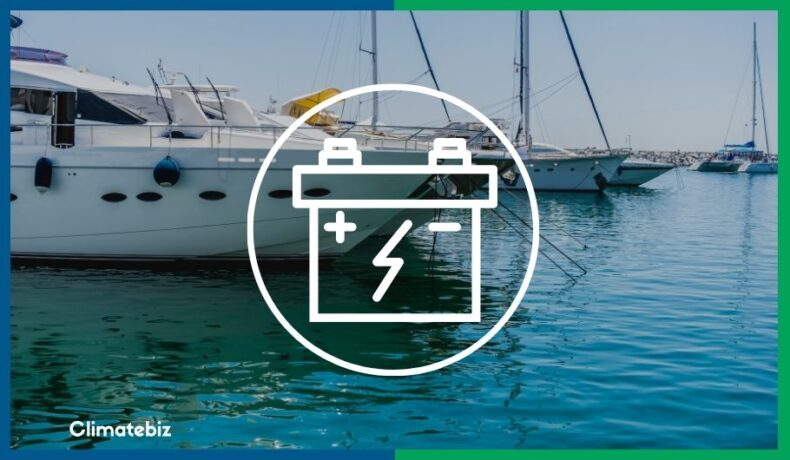Want to learn everything there is to know about marine batteries? Well, we’ve prepared the ultimate marine battery guide to answer all your questions once and for all.
A marine battery is a type of battery specifically designed for use in marine applications. They are an essential part of motor boats and can provide the power needed to start the engine, power trolling motors, charge devices, and run accessories, such as radio, GPS, and fish finders.
Marine batteries are typically deep-cycle batteries. You can completely drain and recharge these batteries regularly; you cannot do the same with cranking batteries.
A deep-cycle marine battery runs reliably and provides sustained power over a long period before you have to recharge it. With proper care, marine batteries can provide years of reliable service.
However, that’s not the only type of marine battery out there. There are three main types of marine batteries: deep cycle, starter/cranking, and dual purpose.
In this article, we’ll discuss in detail each one of these marine battery types. We’ll also list the best deep cycle marine and cranking marine batteries.
But that’s not all; we’ll also answer several questions related to marine batteries, such as:
- What voltage should it be?
- What capacity should it be?
- How frequently should you recharge it?
- How long does it last?
- Can it get wet?
And many more!
Table of Contents
Types Of Marine Batteries
Marine batteries are designed to withstand the harsh marine environment; they’re used to power boats and other marine vessels over an extended period.
There are several types of marine batteries; each has its advantages and disadvantages.
Some marine batteries are designed for starting engines, while others are for deep cycling. Moreover, some are intended to be used in salt water, while others are better suited for fresh water.
Selecting the correct marine battery depends on the specific needs of the application.
There are essentially three types of marine batteries:
- Deep-cycle marine batteries
- Cranking (or “starter”) batteries
- Dual-purpose marine batteries
They have structural differences that vary according to their purpose.
Additionally, each of these types is offered with a choice of battery chemistries: Flooded Lead-acid, AGM (Absorbent Glass Mat), Gel, and most recently, Lithium Iron Phosphate (LiFePO4).
Let’s look closely at each of the three types of marine batteries.
Deep-Cycle Marine Battery
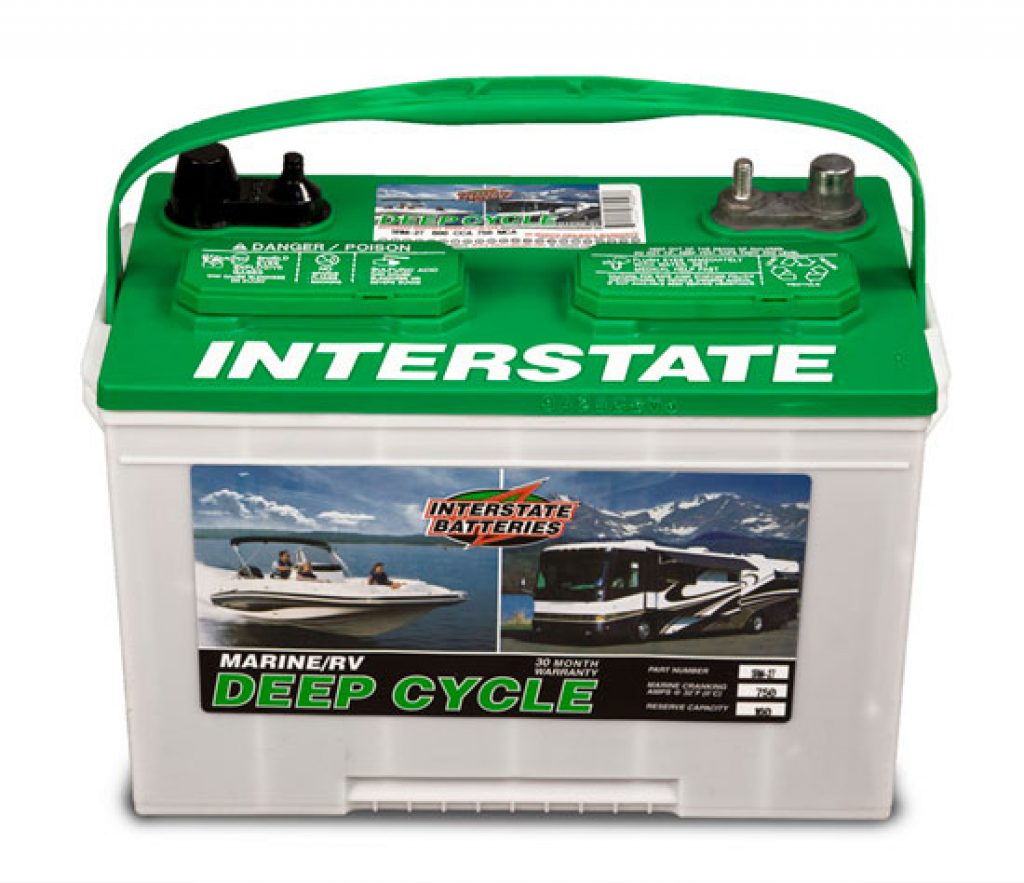
Source: intertatebatteries.com
Deep cycle batteries are specially designed to discharge continuously over a long period. Unlike starter batteries, deep cycle batteries can withstand several hundred charging cycles.
This makes them the best choice for house battery applications since they can provide power for navigation lights, fish finders, and other electronic devices/appliances you have on your boat.
You can also use deep cycle marine batteries in RVs and other applications where a long-lasting, reliable power source is required.
For these reasons, deep cycle marine batteries are ideal for powering trolling motors and other electric battery-powered accessories, including radio, GPS, depth finders, fish locators, and other devices.
There Are Four Main Types Of Deep Cycle Batteries:
- Lead-acid: Flooded
- Sealed Lead-Acid: AGM and Gel
- Lithium Iron Phosphate (LiFePO4)
They all have advantages and disadvantages. However, flooded lead-acid batteries are the least recommended for marine applications, as they can leak and require venting; they are inefficient and potentially dangerous in a boat environment (given the constant vibrations).
AGM and Gel are more resistant to vibrations, especially gel batteries. Gel batteries also have a longer cycle life.
Finally, LiFePO4 is the most advanced type of deep cycle battery. It lasts about 4 to 5 times longer than lead-acid batteries while performing better. For this reason, they tend to be more expensive than lead-acid batteries.
Cranking Marine Battery
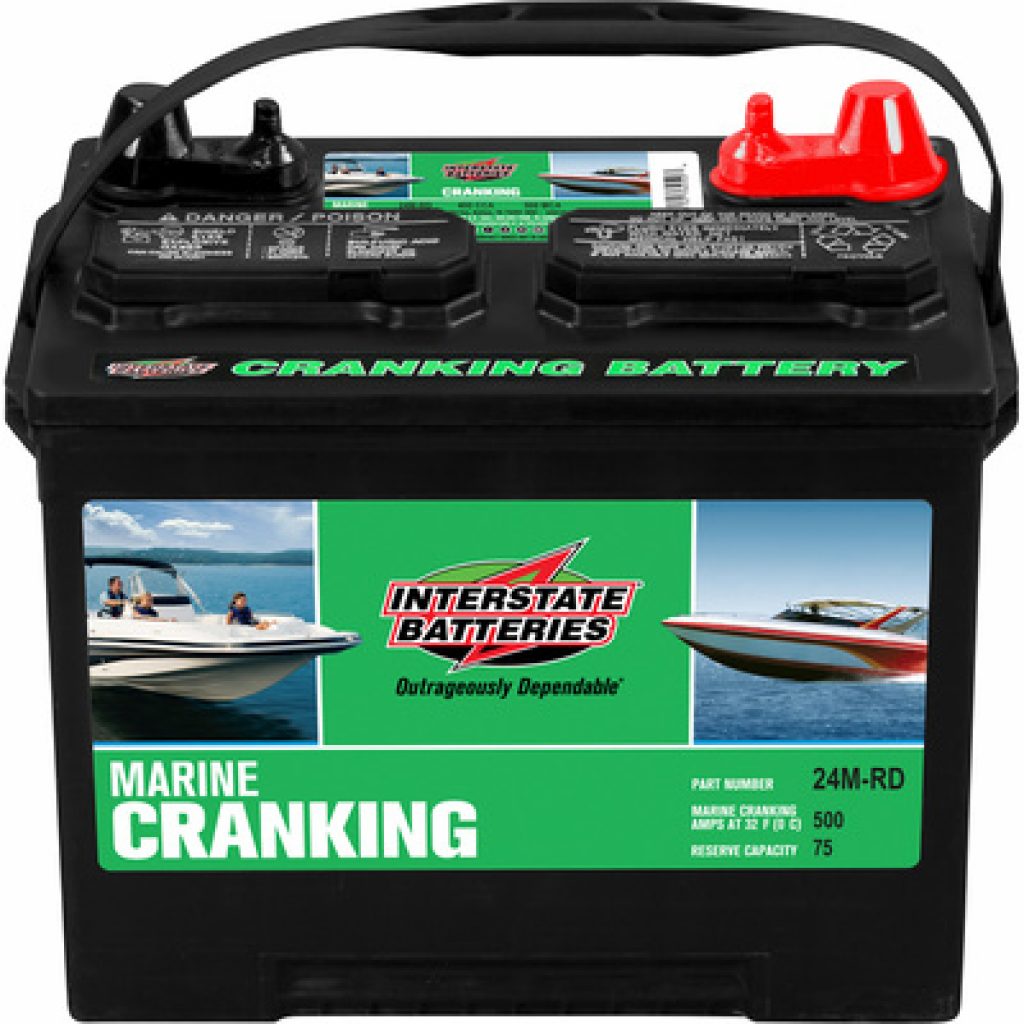
Source: interstatebatteries.com
Cranking batteries — also known as starting batteries — are the sprinters of electrical systems. You’ll primarily use these batteries to start your motor/engine.
A short and intense burst of energy must be sent from the battery to the engine to start a motor; that’s what a cranking battery does.
It delivers a high current burst of energy required to start an internal combustion engine.; this discharge process takes only seconds.
Once the engine is on, the alternator kicks in and starts trickle charging the cranking battery to maintain its full charge.
This type of battery is usually flooded lead-acid, but AGM is also commonly used. They have thinner lead plates, providing increased surface area and facilitating high current discharge.
The drawback of this type of marine battery is that the plates are fragile in high-impact environments, such as boats, which can shorten their lifespan.
Dual Purpose Marine Battery
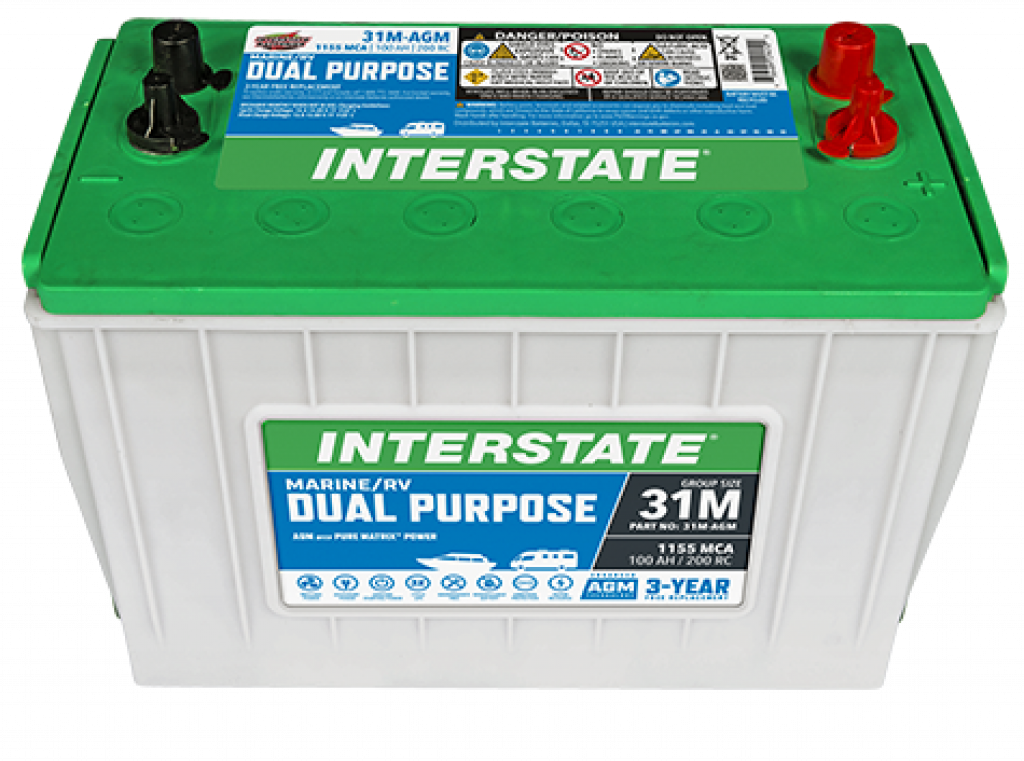
Source: interstatebatteries.com
While deep cycle batteries are built to withstand several discharge/recharge cycles and cranking batteries provide high bursts of current required to start an engine, a dual-purpose battery falls somewhere in between.
As the name implies, dual-purpose batteries can act as deep cycle and cranking marine batteries.
A dual-purpose marine battery can provide enough power to start an engine while also providing enough energy to keep your trolling motor running consistently.
Therefore, it’s basically a “2-in-1”; it works as a starter and deep cycle battery.
What’s Special About Dual-Purpose Batteries?
Once again, the difference lies in the battery’s internal structure.
Dual-purpose batteries have thick lead plates that contain antimony and an active lead paste, which helps them tolerate deep discharges that would ruin a typical cranking battery.
Even though having a dual-purpose battery may seem appealing to some — after all, it’s one less battery to buy and maintain — these batteries are not necessarily a good option for every boat.
They may impact the performance of your motor boat and trolling motor; they also can’t tolerate deep discharges to the same extent as deep cycle batteries.
Moreover, they can overheat in harsh conditions, which is not ideal while a boat is out to sea.
Still, this type of battery can be a good choice for short trips in small powerboats.
Best Deep Cycle Marine Batteries
Best Marine Batteries For Cranking
Difference Between A Cranking Battery And Deep Cycle Marine Battery
A deep cycle battery is designed to be regularly discharged and recharged.
Unlike a marine starter battery, which is designed to supply large bursts of energy for a short period of time, a marine deep cycle battery is meant to provide a steady stream of power over an extended period.
This fact makes deep cycle batteries ideal for powering trolling motors, fish finders, and other electronics used for long periods.
Deep cycle batteries are also more resistant to the damaging effects of heat and vibration, making them ideal for marine applications.
Structural Differences
Although they look the same from the outside, their internal structures have defining differences.
To explain this further, let’s consider the most widely used type of marine battery: lead-acid batteries.
There are three types of lead-acid batteries:
- Flooded Lead-Acid Battery
- AGM Battery
- Gel Battery
Even though they differ in certain aspects, such as the separator used between the lead plates and the amount of electrolyte contained in the battery, they all have lead plates as electrodes and sulfuric acid as the electrolyte.
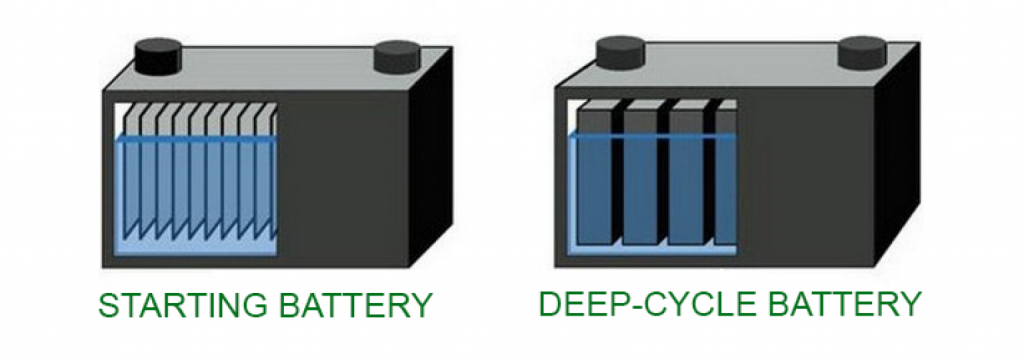
Source: everexceed.com
Since lead is a soft metal, the chemical reactions within the battery can cause the lead plates to bend and lose their shape; this decreases the battery’s performance and overall lifespan.
This issue doesn’t occur as easily in starter batteries because this type of battery only discharges for a very brief period, enough to provide a burst of energy to start an engine.
Conversely, deep cycle batteries discharge for an extended period, making their plates more prone to degradation.
A solution to this problem is to use thicker lead plates, which are less likely to bend and buckle. This slight thickness difference increases their ability to deep discharge.
What Voltage Should My Deep Cycle Marine Battery Be?
When choosing a deep cycle marine battery, it’s crucial to select one with the correct voltage for your needs. Most marine batteries are 12V, although 24V and 36V options are also available.
What Deep Cycle Marine Battery Should You Have?
Well, it depends on the voltage of your boating equipment. For example, if you have a 24V trolling motor, you should have a 24V battery bank.
Similarly, if you have a 36V trolling motor, you should have a 36V battery bank.
The main issue here is that the voltage of your deep cycle marine battery (or battery bank) should be compatible with the voltage required by your devices/equipment.
For instance, if you have a small boat with only one engine, you’ll likely only need a 12V battery. However, if you have a larger boat with multiple engines, you may need to use two or more 12V batteries to achieve the correct voltage for your needs.
You can build 24V, 36V, and even 48V systems by connecting multiple 12V batteries in series. This type of wiring increases the system’s voltage (the total voltage of the system is equal to the sum of the voltages of each battery).
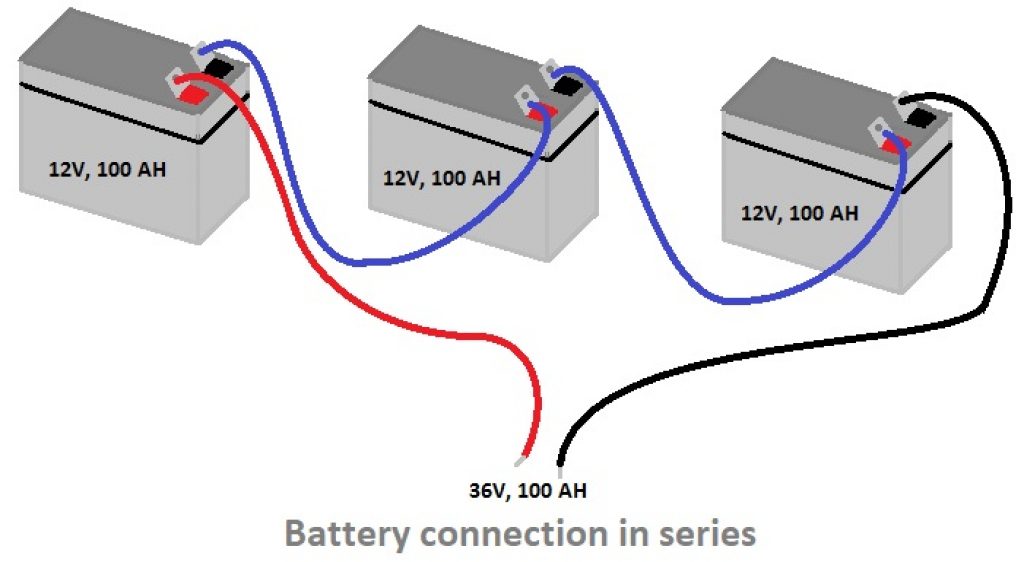
Source: etechnog.com
How Does Voltage Affect Energy Capacity
Deep cycle batteries — like all batteries — are rated in capacity (Ah) and voltage (V). However, the amount of energy a battery can store and provide is expressed in watt-hours. Here’s how we calculate a battery’s energy capacity:
Energy Capacity (Wh) = charge capacity (Ah) x voltage (V)
So let’s consider a 12V 100 Ah battery. This battery can store and provide (at a 100% DoD) 1200 Wh of energy:
Energy Capacity (Wh) = 100 Ah x 12V = 1200 Wh
Now, let’s say you double the voltage of this system while keeping the same charge capacity. In this case, the battery would be able to store (and thus, provide) double the amount of energy:
Energy Capacity (Wh) = 100 Ah x 24V = 2400 Wh
Therefore, choose a deep cycle marine battery with a voltage compatible with your needs. Using a battery with the wrong voltage can damage your battery and the equipment you’re powering with this battery.
What Capacity Should My Marine Battery Be?
One of the most important considerations when choosing a marine battery is capacity.
Deep cycle marine batteries are available in a range of capacities, anywhere from 20Ah to 400Ah.
The size of your boat and the amount of power you use will determine the battery capacity you need.
If you have a small boat with minimal accessories, a 50Ah battery should be enough. However, if you have a large boat with multiple accessories, you may need a 200Ah battery (maybe even larger).
We recommend you check our Boat Battery Size article if you want to learn how to estimate your power demand and choose the correct battery size (in terms of capacity) for your boat.
Choosing the correct capacity marine battery is essential for ensuring your boat has the power it needs to run smoothly.
In general, purchasing a marine battery with a higher capacity than you think you’ll need is always wise. That way, you won’t have to worry about running out of power when you need it the most.
How Frequently Should I Charge My Marine Battery?
The answer to this question depends on a few factors, including your battery type and how often you use it.
For example, if you have a deep cycle battery, you’ll need to charge it whenever the battery reaches a certain DoD (50% DoD for lead-acid batteries and 20% DoD for lithium batteries).
Charging Deep Cycle Lead-Acid Batteries
Lead-acid batteries suffer the memory effect, so you shouldn’t charge them before all of their stored energy is depleted. Additionally, you should never partially charge a lead-acid battery. Always fully charge them.
If you store your lead-acid marine battery for an extended period, make sure you charge it from time to time (every 2 to 3 months) to avoid any capacity losses and lifespan reduction.
Charging Marine Lithium Batteries
You can partially charge lithium batteries, meaning you can charge them more frequently. They also don’t suffer the memory effect. As such, you can charge them before all of their stored energy is used.
Charging Starter Batteries
Always keep your starter battery charged so it can deliver a large amount of power whenever needed.
If a starting battery is left only partially charged, it might not be able to provide the necessary amount of power to start an engine.
You can use a charger to maintain a starting battery fully charged by trickle charging it. Alternatively, you can use your boat’s alternator to keep your starting battery fully charged.
Ultimately, the best way to determine how often to charge your marine battery is to consult your user’s manual or the manufacturer. By following their recommendations, you can help extend the life of your marine battery by charging it correctly.
Can I Trickle Charge A Marine Battery?
Trickle charge is the process of charging a fully charged battery to compensate for its self-discharge rate. This way, the battery remains at a fully charged level.
This state only occurs when no current is being drawn from the battery. Trickle charging will not keep a battery charged if a load is drawing the current.
If you have a marine battery, you may be wondering if you can trickle charge it. The answer is yes; you can trickle charge a marine battery.
A Few Things You Need To Keep In Mind
First, not all batteries require a trickle charge. LiFePO4 batteries, for instance, have a very low self-discharge rate, so trickle charging is not necessary.
Also, deep-cycle lead-acid batteries can be trickle charged to maintain a fully charged state. However, since these batteries provide power for an extended period, you shouldn’t trickle charge them during use (when they’re powering a load).
Conversely, lead-acid marine starter batteries can and should be trickle charged. Why? Because these batteries have a high self-discharge rate and should always be fully charged to provide the burst of energy necessary to start an engine.
Second, marine batteries tend to be sensitive to overcharge. Therefore, you’ll need to monitor the charging process closely and ensure the battery is not overcharging.
With these considerations in mind, trickle charging a marine battery is a viable option.
How Long Do Marine Batteries Last?
To understand how long a battery lasts, we must look at its cycle life.
Cycle life refers to the number of cycles (full charge and discharge) a battery can perform before it loses performance and its capacity drops to about 80% of its initial capacity.
This number varies greatly depending on the battery’s chemistry.
In general, the cycle life of lithium batteries is longer than the cycle life of lead-acid batteries. They are more advanced, so they don’t degrade as quickly over time, nor do they suffer the memory effect — two significant factors that affect cycle life.
Cycle Life: Lithium-Ion Batteries
Here’s a table containing the primary lithium-ion-based chemistries and their usual cycle life:
| Type of Lithium Battery | Cycle Life |
|---|---|
| Lithium Cobalt Oxide – LCO | Between 500 and 1.000 cycles |
| Lithium Manganese Oxide – LMO | Between 300 and 700 cycles |
| Lithium Nickel Manganese Cobalt Oxide – NMC | Between 1.000 and 2.000 cycles |
| Lithium Iron Phosphate – LFP | Between 2.000 and 4.000 cycles |
| Lithium Nickel Cobalt Aluminum Oxide – NCA | Around 500 cycles |
| Lithium Titanate – LTO | Between 3.000 and 7.000 cycles |
Lithium Iron Phosphate (LiFePO4) is the most widely used lithium-ion chemistry in deep cycle marine batteries, home batteries/power stations, and solar batteries.
If properly maintained, LiFePO4 batteries can last over 10 years.
Cycle Life: Lead-Acid Batteries
Now, let’s see the expected lifespan of lead-acid-based batteries:
| Type of Lead-Acid Battery | Cycle Life |
|---|---|
| Flooded (or “Wet”) Batteries | Between 300 and 700 cycles at normal use (50% DoD) |
| Absorbent Glass Mat (AGM) Batteries | Between 400 and 800 cycles at normal use (50% DoD) |
| Gel Batteries | Between 1.000 and 2.000 cycles at a 50% depth of discharge |
Lead-acid batteries generally last from 3 to 5 years if well maintained.
Marine Battery Runtime
Now, if you’re interested in knowing the duration of a cycle — that is, how long until you drain a full battery — you need to know your energy demand.
For example, let’s say you have a 12V 110Ah battery. This system can provide 1,320 Wh of energy because:
Energy Capacity (Wh) = Charge Capacity (Ah) x Voltage (V)
Therefore, Energy Capacity (Wh) = 110 Ah x 12V = 1320 Wh
Wh expresses the amount of power a battery would provide if you completely drained it in 1 hour.
So, if you have a battery with 1320 Wh of energy capacity, and your power demand (considering all your appliances) is 1320W, you would drain your battery in 1 hour (for a 100% DoD).
Similarly, if your energy demand were 660W, your 12V 110 Ah battery would last 2 hours (for a 100% DoD).
You can use the following formula to estimate the runtime of your battery (considering 100% DoD and 77ºF/25ºC):
Running Time (h) = Energy Capacity (Wh) / Your Power Demand (W)
If you need help estimating your power demand, we recommend you look at our Boat Battery Size article.
Can A Marine Battery Get Wet?
A little bit, yes. Most marine batteries are water-resistant, which means they can resist water damage to some degree but not entirely.
Marine batteries are built to withstand the harsh marine environment; they are designed to be durable and water-resistant.
Most marine batteries are sealed, maintenance-free batteries.; this means that they do not need to be regularly checked for water levels and do not require special care.
However, it’s still important to read the manufacturer’s instructions carefully before using a marine battery to ensure that it’s compatible with your boat and adequately installed.
Protect The Battery Terminals
Even though most marine batteries can get a bit wet, their terminals can corrode over time, damaging the battery. For this reason, it’s essential to dry them off after they’ve been exposed to water. There are, however, “marine grade” terminals, which are corrosion resistant.
Another factor you should consider is the amount of water; avoid letting marine batteries get too wet. If you submerge the battery in water, it can suffer a short circuit, which would permanently damage the battery.
In Summary
It’s okay if your marine battery gets a few splashes of water – just don’t let it soak in water for an extended period.
Why? Because if you submerge a marine battery in water — especially saltwater, which conducts electricity — the battery will drain faster, decreasing the battery performance and lifespan. What’s more, it may damage the battery casing over time.
Ideally, you should keep your battery in a dry, enclosed space, but if your battery gets a few splashes of water, it shouldn’t suffer any major problems. What you should pay extra attention to is if the terminals get wet.
If your battery gets wet often, a good idea is to buy a battery box and/or use a terminal protection gel to protect the terminals from corrosion, especially if you’re sailing in salt water.
Do Marine Batteries Have Cranking Amps?
Depending on the size of the boat (or rather the boat’s engine), you’ll need different amounts of cranking amps.
Typically, the starting current of a compact car is in the 150A to 200A range. For boats, the range is between 75A and 400A, depending on the battery’s voltage.
Cranking batteries have cranking amps. Their design allows them to provide a high current burst during a very short amount of time.
On the other hand, deep cycle batteries are not suited for starting an engine, though that doesn’t mean they can’t provide cranking amps.
If your boat’s engine requires a low cranking amperage and you have a good enough (in terms of high peak current rating) deep cycle battery, it could, technically, provide those cranking amps.
However, doing so might negatively impact the battery’s performance and lifespan.
Therefore, check your battery’s tech specs to determine if they can provide the cranking amps your boat needs.
What Does RC Mean On A Marine Battery?
RC means Reverse Capacity. It’s a rating commonly seen on deep-cycle lead-acid batteries.
What does reverse capacity mean? You might ask.
Reverse capacity is the amount of time (in minutes) that a battery can provide 25A continuously, at 80°F (~27ºC), until the battery reaches a low SoC (until the battery voltage drops to a certain point, 10.5V for 12V batteries).
For instance, a marine battery with an RC of 100 will last 100 minutes when supplying 25 amps of power at 80ºF.
In other words, it measures how long the battery will last under a moderate load.
A higher RC rating means that the battery will last longer before needing to be recharged.
However, the RC rating varies with temperature. So, in cold weather conditions, you’ll need to monitor your battery’s power level and recharge it more often.
What Does CCA Mean On A Marine Battery?
CCA stands for “cold-cranking amps.”
It’s a measure of how much electrical current a battery can deliver for 30 seconds at 0 degrees Fahrenheit without the battery falling below 1.2 volts per cell (7.2V for a 12V battery).
In a way, it measures how well a marine battery will perform in cold weather conditions.
A marine battery with a high CCA rating can start an engine in cold weather more easily than a marine battery with a low CCA rating. In other words, the higher the CCA rating, the greater the battery’s starting power.
Cold Cranking Amps or “CCA” is one of several factors to consider when choosing a marine battery. Other factors include capacity (measured in amp-hours), reserve capacity, and weight.
For marine batteries, this rating is often referred to as “marine cranking amps” or MCA. The MCA rating tells you how much current a marine battery can deliver at 32ºF (0ºC) for 30 seconds without falling below 7.2V (for a 12V battery).
Final Thoughts
That’s it for our guide on marine batteries!
Marine batteries are a critical component of any boat and, as such, should be chosen with care.
Size, type, and quality are all crucial factors for you to consider when making your purchase.
We hope this guide has given you the necessary knowledge to make an informed decision about the best marine battery for your marine vessel.
If you have any questions we didn’t answer, feel free to leave them in the comment section below, and we will get back to you as soon as possible.
Thanks for reading, and happy sailing!

